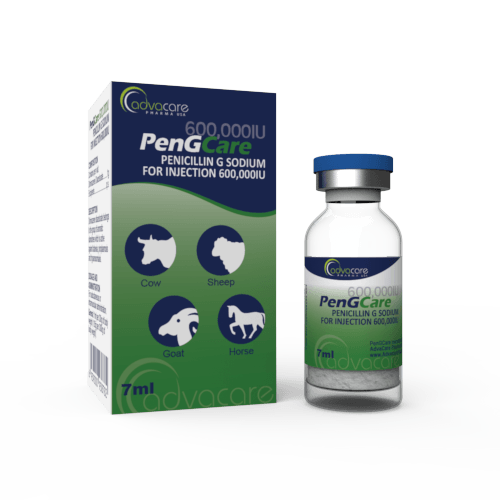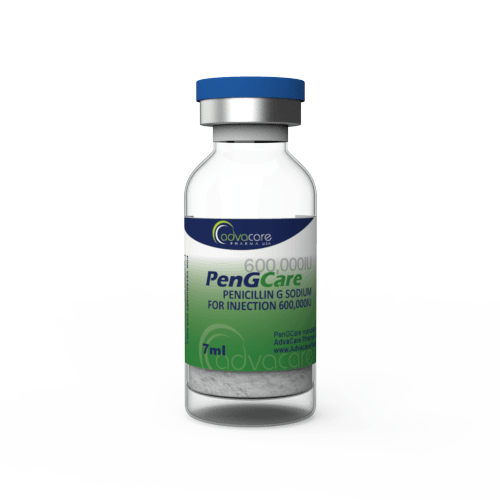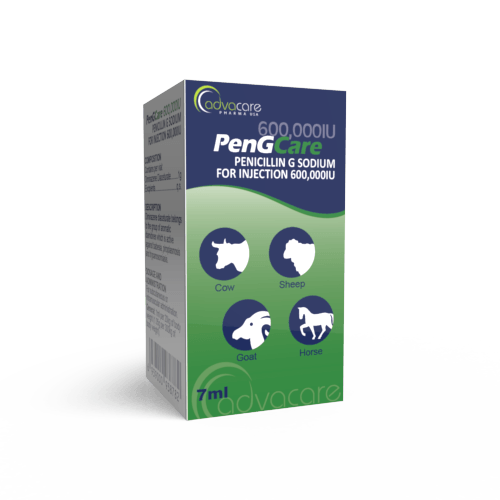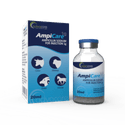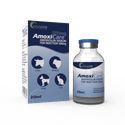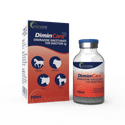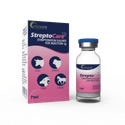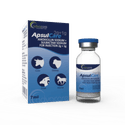- Home›
- Veterinary Pharmaceuticals›
- Veterinary Injections›
- Veterinary Powders for Injection›
- Penicillin G Sodium for Injection
Penicillin G Sodium for Injection
Dosage
Packaging
What is Penicillin G Sodium?
Active Ingredients: Penicillin G Sodium
Penicillin G Sodium for Injection is a fast-acting penicillin antibiotic used for many types of bacterial infections in horses, companion animals, and livestock animals like cows, sheep, and swine. Penicillin sodium is typically used if penicillin potassium is unsuitable for a patient.
Penicillin G sodium is a penicillin antibiotic. It is the salt form of penicillin G (benzylpenicillin). It works by inhibiting mucopeptide biosynthesis. This antibiotic is effective against infections caused by Corynebacterium diphtheriae, Bacillus anthracis, Clostridia, Actinomyces bovis, Streptobacillus moniliformis, Listeria monocytogenes, and Leptospira. It is efficient against many gram-positive bacteria and a limited number of gram-negative bacteria. It is also effective against anaerobic microorganisms because it belongs to the group of narrow-spectrum beta-lactamase-sensitive penicillins.
Penicillin sodium for Injection is manufactured as a powder for reconstitution. It is intended to be administered intramuscularly. Penicillin Potassium may cause pain on injection. If the animal cannot tolerate the pain, sometimes it is administered with Procaine or another numbing agent.
Penicillin G sodium for Injection is a fine powder designed to be reconstituted for injection into the body. This antibiotic remains stable in acidic environments and is easily absorbed when administered through injection. Absorption may be delayed because the drug stays in the bloodstream and tissues for a longer time. The antibiotic is distributed throughout the body's fluids and tissues but does not typically cross certain barriers unless given in high doses. In animal pregnancies, the volume of distribution may increase. Penicillin is excreted unchanged, undergoing minimal metabolic changes. Approximately 90% of the drug is eliminated through urine within 6 hours, mainly through glomerular filtration and active tubular secretion. There is also a possibility of excretion through bile and trace amounts in milk.
It is important to note that this formulation of Penicillin sodium is for veterinary purposes only. While AdvaCare Pharma offers many similar products that are available for human use, this particular medication should be prescribed by a veterinary doctor or animal care specialist for an animal. Also, it should be applied by a professional.
AdvaCare Pharma is a trusted global supplier of Penicillin G Sodium for Injection. We offer a comprehensive range of veterinary products that are available for global distribution. These veterinary medications are produced in GMP-certified factories.
Why are we a trusted Penicillin G manufacturer?
AdvaCare Pharma is a leading GMP manufacturer of Penicillin G Injection for veterinary use. Our company was established with the aim of providing excellent value to our veterinary distributors by concentrating on competitively priced, high-quality veterinary pharmaceuticals with market-tailored solutions.
Over the past 20 years, AdvaCare Pharma has proven to be a trusted Penicillin G manufacturer and supplier of 100+ veterinary injections in over 65 countries.
Uses
What is Penicillin G Sodium used for?
It's used to treat bacterial infections such as:
- respiratory infections
- navel infections in cows
- foot rot in cows
- wound infections in cows and pigs
- mastitis in swine
- otitis externa in dogs and cats
What animals can be treated with Penicillin G Sodium for Injection?
This medicine is recommended for livestock animals like camels, cows, pigs, goats, or sheep. It's also used to treat horses and companion animals like cats and dogs.
How is Penicillin G Sodium for Injection used?
This drug has been manufactured as a powder for reconstitution. It should be mixed with sterile water before administration and should be given as soon as possible. This medicine can be administered by the intramuscular route. If doses are repeated, the site of injection should change each time. It is absorbed better than other penicillins and has fewer side effects (vomiting, nausea, diarrhea, stomach upset). It should also be given less frequently.
Why is Penicillin G used in animals?
It is primarily used for treating gram-positive bacteria. It can also be successful in the treatment of gram-negative. Gram-negative bacilli and cocci are susceptible to large parenteral doses of Penicillin G. This antibiotic is effective in treating Bacterial pneumonia caused by Pasteurella multocida in cattle and sheep. Erysipelothrix rhusiopathiae in swine and Streptococcus equi in horses can be treated with this antibiotic.
This antibiotic shows no effects or minimal effects in treating many anaerobic gram-negative bacilli. Before adding and prescribing this antibiotic to animals, a detailed antibiogram should be performed.
How can Penicillin G Sodium for Injection help in treating pneumonia in livestock?
Pneumonia by Pasteurella multocida is usually a secondary disease in animals that have pre-existing damaged airways. Adding Penicillin G to these animals can reduce the symptoms of the diseases and reduce the number of bacteria. It will improve clinical symptoms like fever, rapid breathing, and nasal discharge.
How can Penicillin G Sodium for Injection help companion animals?
In companion animals, this drug is used for treating otitis externa which is caused by bacteria. After diagnosing and performing an antibiogram, this antibiotic can reduce the signs of scratching, itchiness, and head shaking in companion animals.
Is Penicillin G enough for treating a disease?
It depends on the diagnosis, but sometimes it can be enough. The veterinarian should decide depending on the antibiogram and the diagnosis. Very often, various supplements are being added during the treatment of many diseases.
How should Penicillin G Sodium for Injection be stored?
This medication should be stored in a dark, dry location under 25°C.
What are the withdrawal times for Penicillin G Sodium?
The withdrawal time is 5 days for slaughter. For milk, the withdrawal time is 72 hours. The time of withdrawal depends on the country’s regulatory requirements. It must be followed to prevent food residues and consequent public health implications.
Dosage
How much Penicillin G Sodium should be given to horses?
For gram-positive infections, the usual dose is 10,000-20,000 Units/kg, given every 6 hours IV/IM. For serious gram-positive infections in foals, the usual dose is 22,000-44,000 Units/kg, given every 6 hours IV.
The dosage depends on the animal’s current condition, species, weight, and age.
Refer to a veterinary doctor or pharmacist for guidelines on dosage.
Side Effects
As with all pharmaceuticals, some unwanted effects can occur from the use of Penicillin G Sodium for Injection.
Common side effects include but are not limited to:
- gastrointestinal effects (diarrhea, loss of appetite)
- pain at the injection site
Serious side effects may include:
- allergic reaction and anaphylaxis
- severe loss of appetite in cats
In the event of a serious allergic reaction, Epinephrine (Adrenaline) 1:1000 should be administered immediately.
Observe the animal with professional care after Penicillin G administration. The most serious side effects are visible within minutes. If you observe some unusual changes, contact a professional, or if you are a veterinarian, manage the problem as soon as possible.
For a comprehensive list of all possible side effects of this medication, consult a veterinarian.
Precautions
Do NOT use Penicillin G Sodium for Injection for an animal that: • has a known allergy or hypersensitivity to penicillin.
Treatment with this drug should be administered with caution in an animal that:
- is hypersensitive to other beta-lactam antibiotics such as cephalosporin.
- has an electrolyte disorder.
- belongs to one of the following species: snakes, rabbits, guinea pigs, gerbils, hamsters, or chinchillas.
- is pregnant or lactating.
This is one of the safest antibiotics for pregnant and lactating animals. However, the veterinarian should decide whether the antibiotic is appropriate for the animal.
Before prescribing penicillin G, it is advisable for a veterinarian to assess patients with chronic kidney disease. Given that biotransformation and excretion primarily occur in the kidneys, these patients typically exhibit low glomerular filtration.
If the farmers or veterinarians miss a dose, never give an animal two doses at once or extra doses. If a dose is missed, skip that dose and continue with the next dose at the scheduled time.
This medication should not be administered via the vein. The only acceptable method of administering this antibiotic is via intramuscular injection.
What are the most common animals for which Penicillin G Sodium for Injection is used?
Penicillin G Sodium for Injection is primarily used for treating bacterial infections in companion animals and livestock. The specific common uses of Penicillin G Sodium for Injection include treatment of the following:
- pneumonia
- foot rot
- soft-tissue infections
- open-wounds infections
- mastitis
- otitis externa
Companion Animals Bacterial Infections
Penicillin G Sodium for Injection in companion animals is an effective antibiotic against many respiratory diseases and diseases caused by most gram-positive bacteria. It is particularly used for treating otitis externa caused by bacterial pathogens.
Ruminants (Cow, Goat, and Sheep) Bacterial Infections
This medication is particularly used for addressing severe infections in cows, including respiratory infections and mastitis. It can also help in treating foot infections (such as foot rot), and certain skin infections.
Horse Bacterial Infections
In horses, this drug can be used for treating diseases caused by gram-positive bacteria. It is especially recommended for respiratory infections and open-wound infections.
Swine Bacterial Infections
In swine, this antibiotic can be used for treating mastitis and metritis mostly. It can also be used for treating gastrointestinal diseases or serious respiratory infections based on the antibiogram.
The intention for use should be determined by a professional veterinary doctor based on the diagnosis and antibiogram tests. When needed, this antibiotic should be combined with other drugs and supplements for a full recovery.

You might be interested in...
Why AdvaCare Pharma?
As an industry leader, we are aware of our responsibility to provide affordable and sustainable solutions to improve healthcare worldwide.
